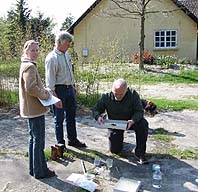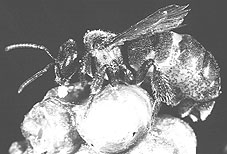Home
Aussie Bee Online
Welcome
New Articles
About Native Bees
Bee Photo Gallery
Bees in Your Area
Common Questions
Rescuing Native Bees
Exotic Bumblebees
What are Stingless Bees?
Buying Stingless Bees
Honey Production
Crop Pollination
Study Native Bees
Field Guide
Information Booklets
Tim Heard's Book
John Klumpp's Book
Aussie Bee Back Issues
Seminars
Links
Support Native Bees
Aussie Bee Shop
Order Form
Who We Are
Donations
Privacy Policy
Free Newsletter
Website Survey
Download Printer-Friendly PDF version of this article
Secrets of Stingless Bee Breeding: The Results are In!
Dr Anne Dollin
Australian Native Bee Research Centre
August 2002
The tiny size of our Australian stingless bees makes observing their behaviour very challenging! How many drones mate with a virgin queen bee when she soars away on her mating flight? Does the queen bee lay all the eggs in the brood comb? Kellie Palmer of the University of Sydney used DNA analysis techniques to answer these questions with some surprising results.
 |
Kellie Palmer recently finished her PhD studies in Dr Ben Oldroyd’s Beelab at the University of Sydney. She had never seen stingless bees until she saw the observation hives kept in the Beelab’s temperature controlled room. She was fascinated by these bees and was keen to include some studies of their mating and egg laying behaviour in her PhD research program.
Australian stingless bee keepers, Tom Carter, Wendy Forno and Dick Ash, kindly posted Kellie samples of brood from their hives. Kellie received samples from four colonies each of Austroplebeia symei, Trigona carbonaria, Trigona hockingsi and Trigona clypearis, and from one colony of Trigona sapiens.
Kelly used DNA analysis of the bees’ genes to answer questions about their mating and egglaying behaviour. She could distinguish between male and female bees and trace family trees in the nest, simply by studying gene patterns, because bees have a very unusual system of reproduction. Female bees (workers and queens) develop from fertilised eggs and have two sets of genes. Male bees (drones) develop from unfertilised eggs and have only one set of genes.
The Mating Behaviour
In commerical honeybees (Apis mellifera), a virgin queen mates with many different males during her mating flight. Yet in most overseas species of stingless bees, the virgin queen mates only once. What would Kellie discover in our Australian stingless bees?
Kellie extracted some gene markers from the DNA of the developing worker bees in the brood comb samples. She found no more than three different gene markers in the workers from each nest. Two of these gene markers would have come from their mother (the queen bee). So only one gene marker could have come from their father’s side. This meant that there was only one father in each nest and all of these queen bees (representing five Australian species) had mated only once.
So Kellie has shown in five Australian stingless bee species that the virgin queen bee mates only once. Kellie’s DNA analysis method was far more elegant and reliable than trying to watch a tiny virgin queen during her mating flight with a pair of binoculars! It seems that our Australian stingless queen bees are similar to overseas stingless bee species in this mating behaviour.
The Egg Laying Behaviour
When a virgin queen mates during her mating flight she stores the sperm in a special sac in her body. Later when she begins to lay eggs she can choose whether or not to fertilise each egg with some of this sperm. If she fertilises the egg it will develop into a worker or a queen. If she does not fertilise the egg, it will develop into a drone.
Worker bees can lay eggs too but they never mate. Because they have no sperm stored in their bodies, workers cannot fertilise their eggs and any eggs that workers lay will develop into drones. Mathematical studies of the genetic relationships in a nest predict that if a queen mates many times, workers will not tend to lay their own eggs; but if the queen mates only once, workers will tend to lay their own eggs.
In commercial honeybees (Apis mellifera) the queen bee mates many times and she normally lays all the eggs in the hive. The hundreds of worker bees in the hive devote their lives to feeding and caring for the offspring of the queen bee, sacrificing their own ability to lay eggs. In contrast, in some South American stingless bee species the queen bee mates only once and the worker bees lay most of the drone eggs in their nests.
What happens in our Australian stingless bee nests? Again Kellie found the answer by using DNA analysis techniques rather than by maintaining a ‘round the clock’ watch on the bees’ egg laying behaviour.
 |
Kellie extracted some gene markers from developing drones in the brood comb samples. Her analysis of these markers produced a surprising result. In sixteen of the nests that she studied, Kellie discovered that none of the drones had been laid by workers. She only found worker-laid drones in one Austroplebeia symei nest, and even in this nest only 15% of the drones had been laid by workers.
Aussie Bees Amaze the Researchers
Once again our Aussie stingless bees have amazed the researchers! In South American species where the queen mates only once, worker bees normally lay most of the drone eggs. Our Australian queen bees mate only once too, but somehow they are preventing their workers from laying drone eggs! How are they doing this? There are still many more mysteries to be unravelled by future researchers about Australian stingless bees.
• Download the PDF version of this article.
(If you have not used PDF before, click here.)
• For more interesting Aussie Bee Online articles on native bees, visit the contents
|
Please feel free to print out this article or to email copies of the PDF version to your friends. This article may also be reproduced or hosted on other websites providing it is kept in its full and unaltered form including ANBRC contact details.
|
Search Aussie Bee Website:
© 1997-2018 Australian Native Bee Research Centre
PO Box 74, North Richmond NSW 2754, Australia